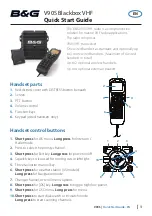
External Connections:
J1, J2, and J3 are Molex header connectors with standard 0.025” square pins and a 0.1” pin-to-pin spacing. This style is
extremely common and a large number of mating, female connectors with different termination styles are available. These
styles include solder, crimp, and insulation displacement termination. The mating connectors are not included in this kit.
The following illustration shows all the external connection options.
Relay vs. Transistor Output Configuration:
For operation with
relay outputs
, the three jumpers; J4, J5, and J6 must all be open (not shorted). D1, D2, RL1, and RL2 are
installed. Outputs are taken from J2 and J3 as shown in the tables above.
For operation with
transistor outputs
, the three jumpers; J4, J5, and J6 must all be shorted. This can be done with a wire
jumper or by touching their small gaps with a drop of solder on the tip of the iron to create a solder bridge. D1, D2, RL1, and
RL2 are not installed. Outputs are taken from J3 as shown in the table above. With no pull-up resistors on the board the
transistor outputs will be “open collector” style where the load circuit provides the pull-up Voltage. If pull-up resistors are
needed, they can be installed in the locations marked for D1 and D2: ¼ Watt resistors will fit in these locations. For most
applications that require a pull-up resistor, values between 1K and 10K Ohms would be chosen. Actual values for these
resistors would be calculated from the current requirements of the circuit that is connected to these outputs. As the supply
Voltage for the receiver circuit is 5V, pull up resistors lower in value than 100 Ohms would exceed the power rating of a
1/4W resistor and should be avoided ( 5*5/100 = 0.25 W). In general the higher the value, the better as long as enough
source current is available for the driven circuit. As a wide range of values may be needed, these resistors are not provided in
this kit.
Output Actions:




























